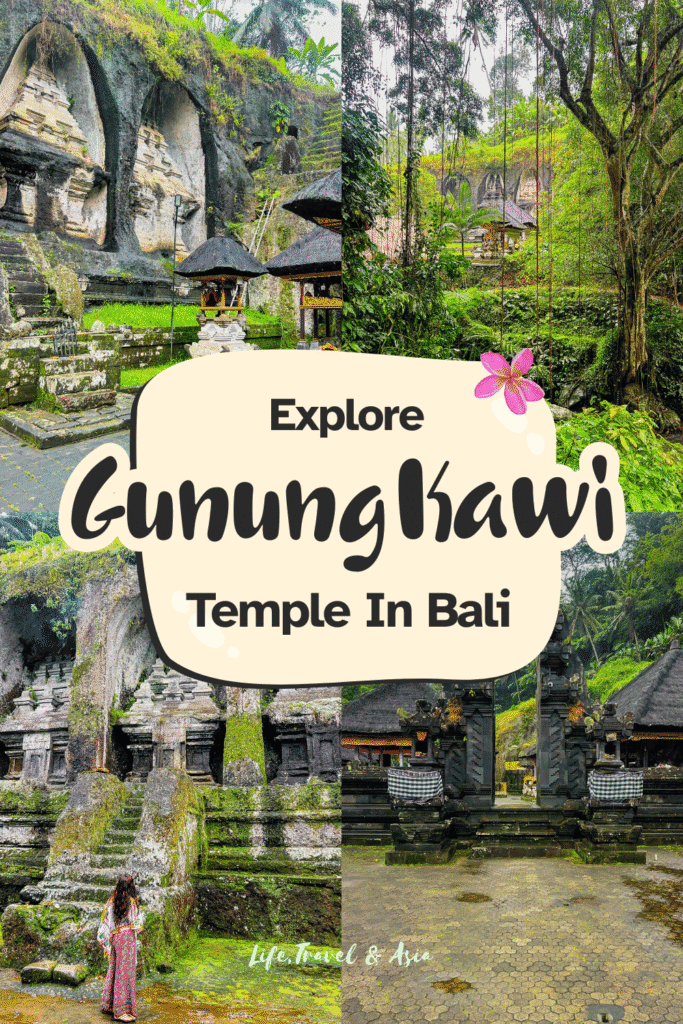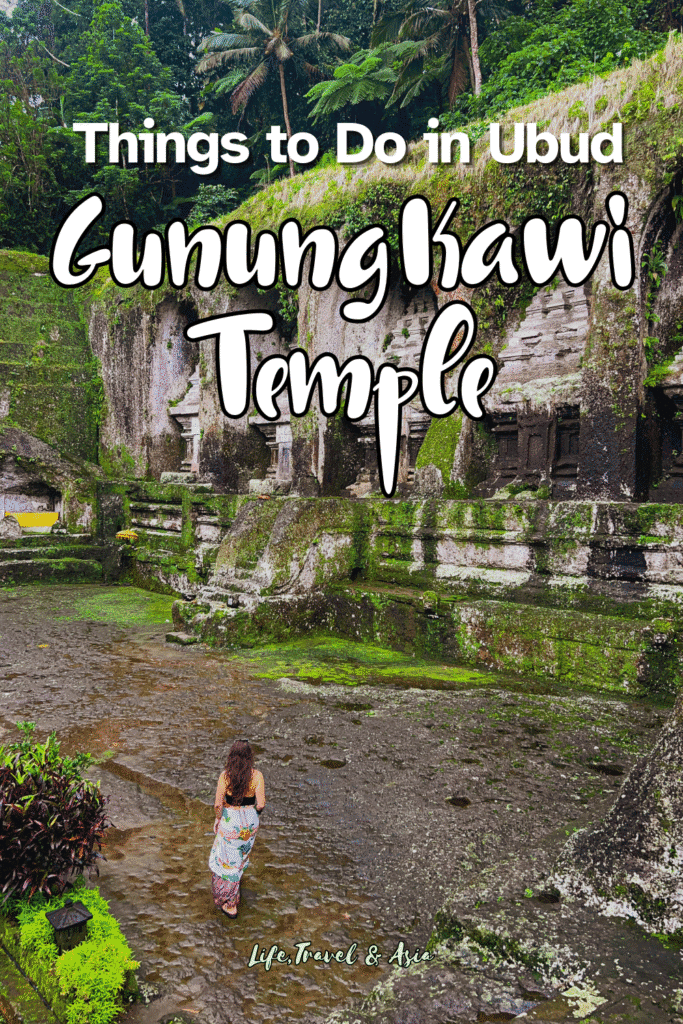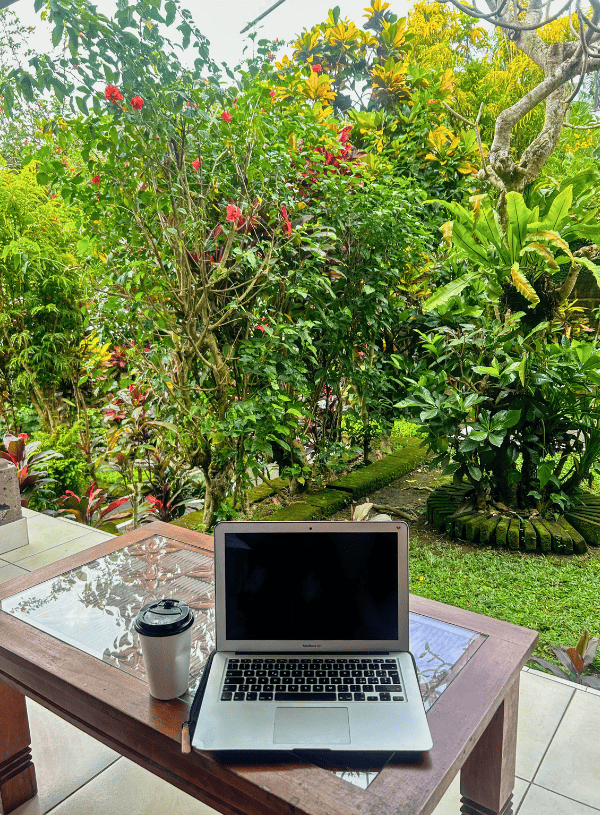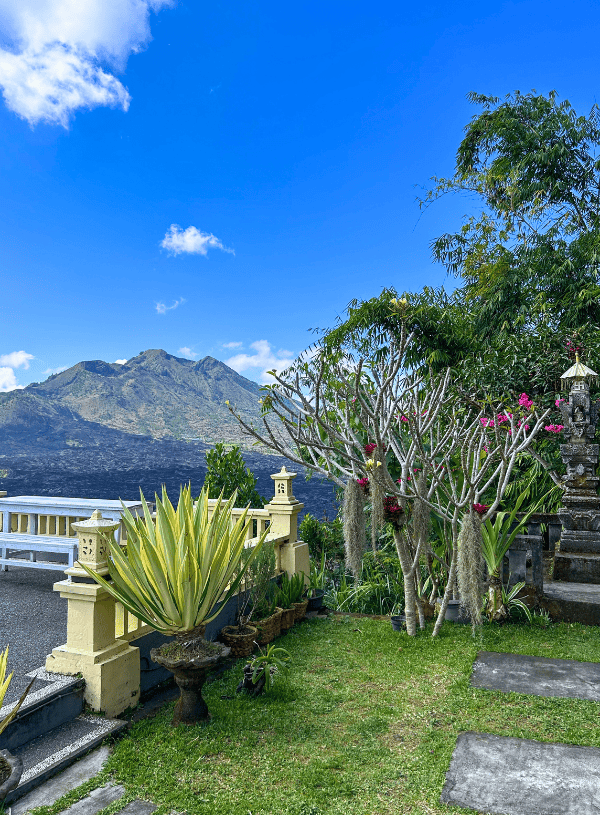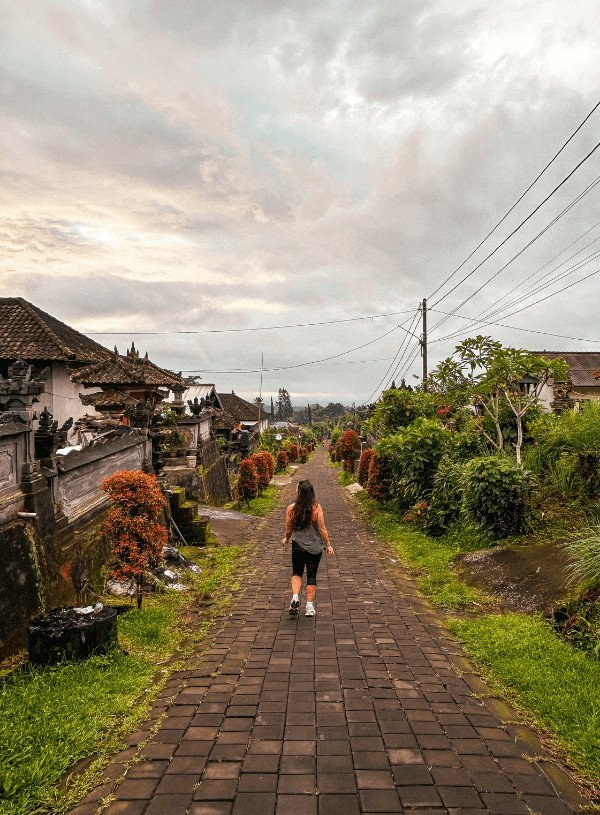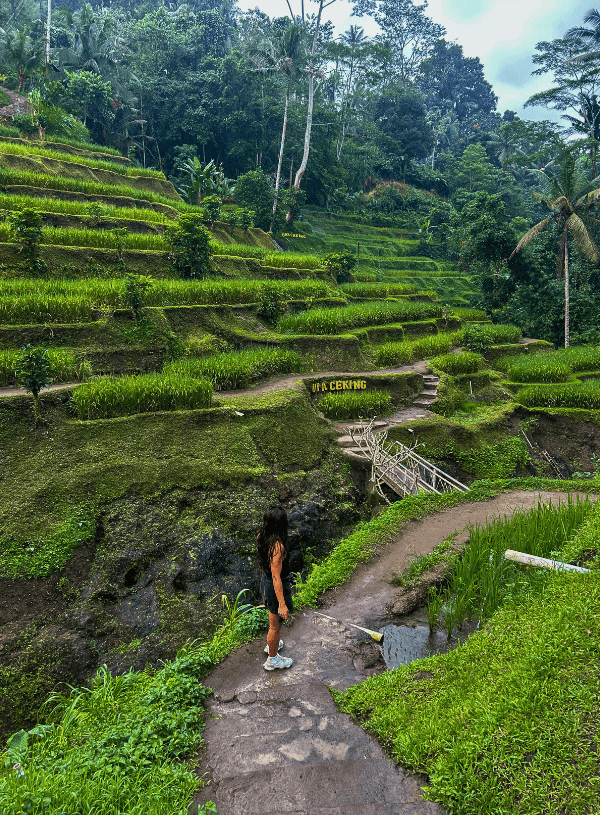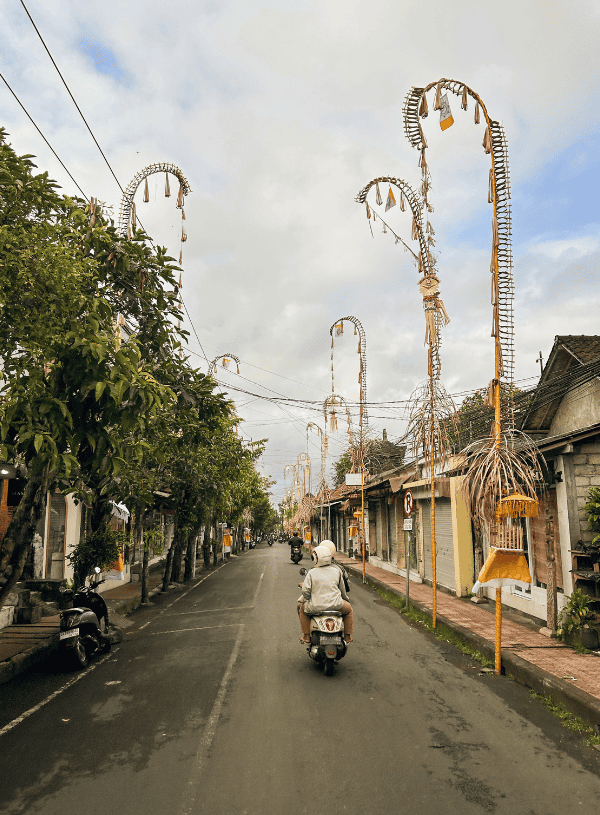Gunung Kawi Temple: Is This Bali’s Most Mystical Sacred Site?
Last Updated on July 7, 2025
The first time I looked up Gunung Kawi Temple online (after the guide who led me through my purification ceremony recommended it), the first thing that popped up was a picture of those mystical, towering shrines carved into the hillside. Those were exactly what drew me in and convinced me to visit Gunung Kawi Temple in Tampaksiring.
So, on a cloudy morning in this weirdly rainy June, I hopped on a Grab bike and made my way there. As soon as I arrived, two things immediately won me over: the lush Mancigan rice fields surrounding the temple and the thick jungle covering the valley of the Pakerisan River that runs through the site.
Oh, and of course, those majestic shrines standing tall in two separate areas of the temple, almost watching over the whole place.
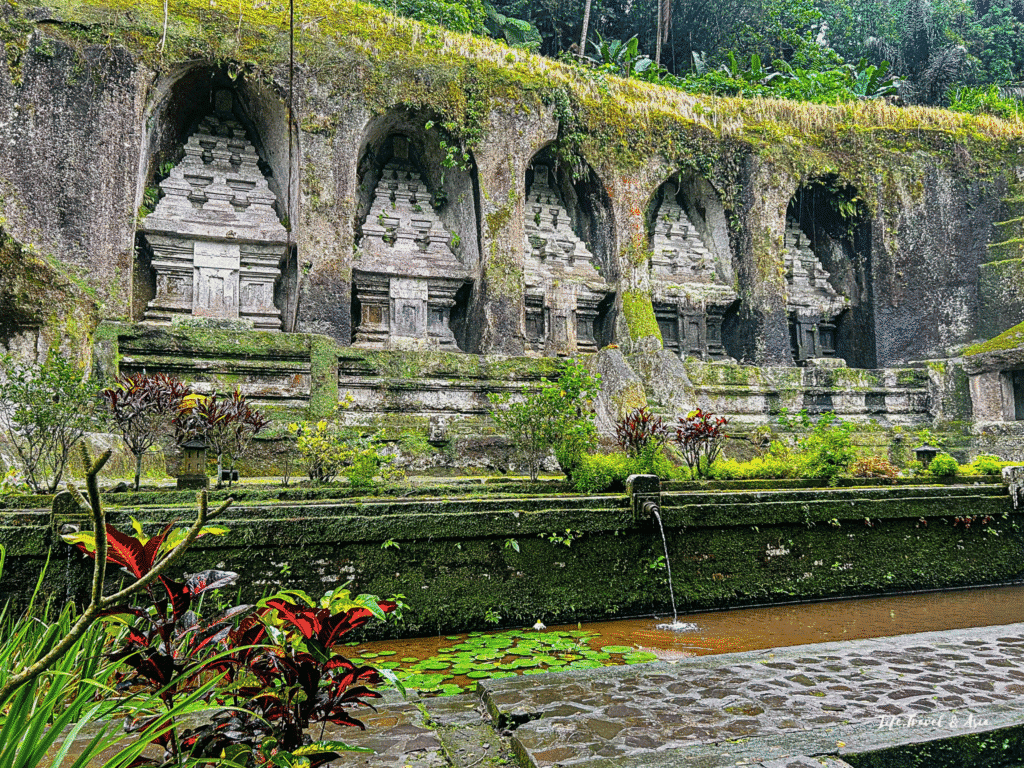
After exploring the temple, I can confirm it’s one of the most mystical sites I’ve visited in Bali — partly because it’s not just a temple, but a commemorative funerary complex dedicated to ancient Balinese and Javanese kings.
In this blog post, I’ll share everything you can (and can’t) expect from your visit, plus all the tips to plan your trip as easily as possible.
This article may contain affiliate links. This means that if you purchase through one of the links, I may be paid a small commission at no extra cost to you. Thank you for supporting the blog and allowing me to keep sharing meaningful travel experiences with you.
What Makes Gunung Kawi Temple Special?
Gunung Kawi Temple is one of the most ancient and fascinating sites on the entire island of Bali. Built around the 11th century, it’s often called the Valley of the Balinese Kings.
While the temple itself doesn’t actually house the tombs of ancient kings (which honestly would have added even more reverence to this already incredibly atmospheric place), the shrines are dedicated to past rulers, their concubines, and the tenth Candi, hidden from the others, is believed to honor a royal minister.
The true purpose of these Candis remains unknown. Still, one of the most special aspects of this site is its history as a sanctuary for Buddhist monks to meditate and pray, much like Goa Gajah, showing how Hinduism and Buddhism peacefully coexisted in Bali’s spiritual past.
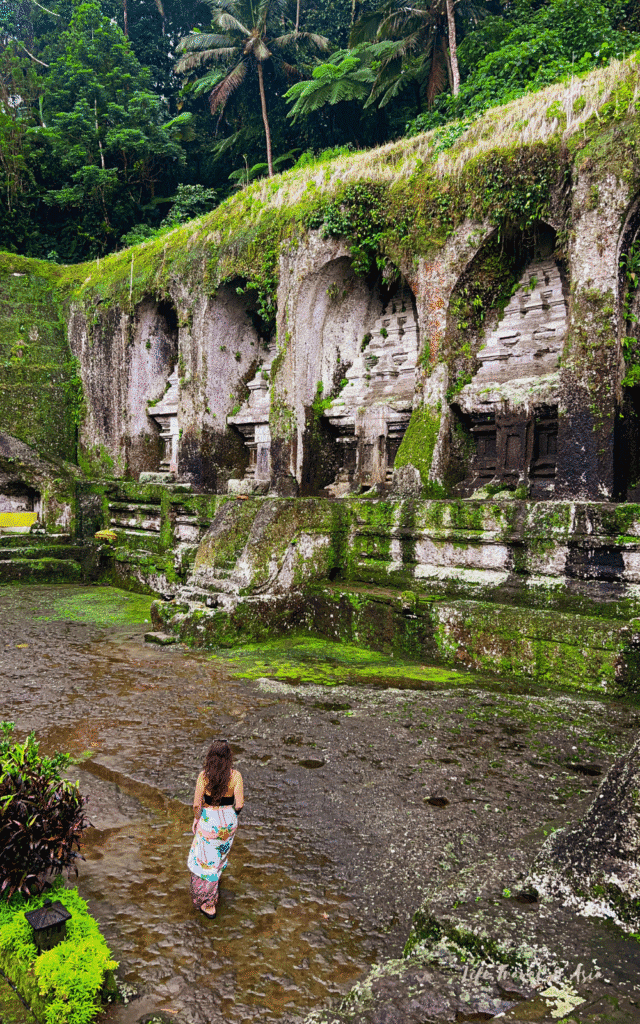
Both cliff sides, carved with these ancient shrines, are impressive, and what makes this place so captivating.
Walking just beneath these towering rock-cut structures, completely alone, with only the sound of the Pakerisan River flowing behind me, honestly made me feel like I was exploring forgotten tombs from another time. (I’ve always wanted to be an archaeologist; no wonder I feel this way every time I find myself wandering alone in an ancient temple.)
But beyond the shrines and the sacred atmosphere, what truly makes this site unforgettable is the natural surroundings. A dense jungle completely encloses the valley, giving the place a slightly eerie yet magical feel — after all, it is a funerary complex.
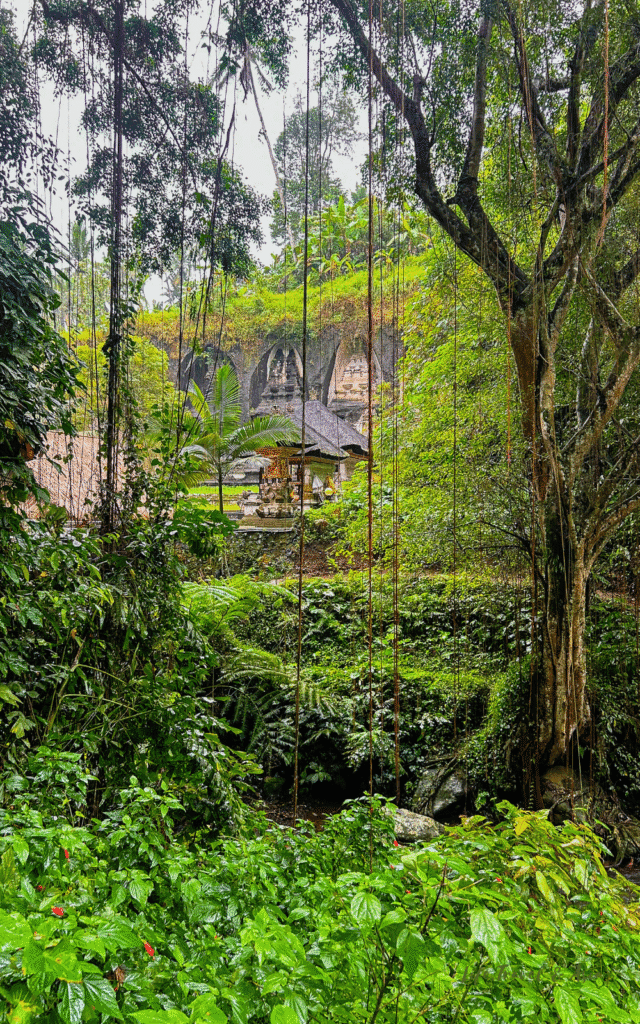
The Pakerisan River cuts through the valley, with the two sides of the temple connected by a small wooden bridge. The sound of the water almost drowned out the chatter of a group of Japanese tourists who arrived just as I was leaving.
The temple sits hidden at the bottom of the valley, embraced — almost protected — by towering trees as if nature itself wanted to keep it sacred and untouched. The branches of the banyan trees hang low, nearly brushing the river and gently swaying over your head as you explore.
In the distance, you can hear the soft rush of a small waterfall feeding the river, adding to the almost otherworldly atmosphere of the site.
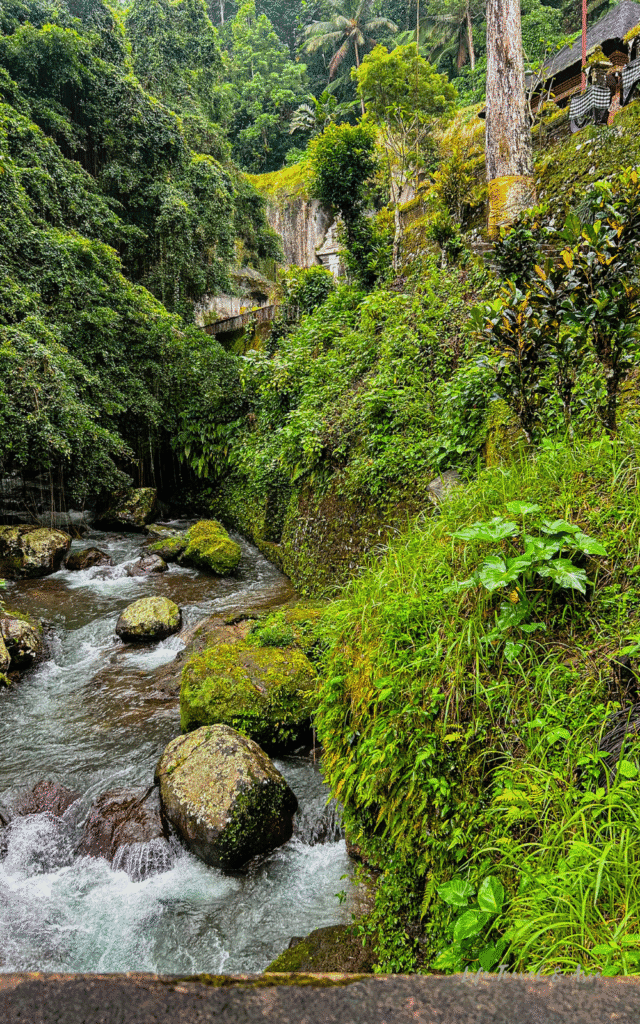
What I Didn’t Like: My Honest Take
Since this is meant to be an honest review to help you decide whether Gunung Kawi Temple is worth your time, here’s what I didn’t like.
In general, I’m not a fan when a site in Bali starts becoming more popular, and suddenly souvenir stalls pop up along the path to the temple. Honestly, this kind of commercialization detracts from the site’s sacred atmosphere.
Unfortunately, this is the case for Gunung Kawi Temple, so the whole entrance area already lowered my expectations a little, which was a shame.
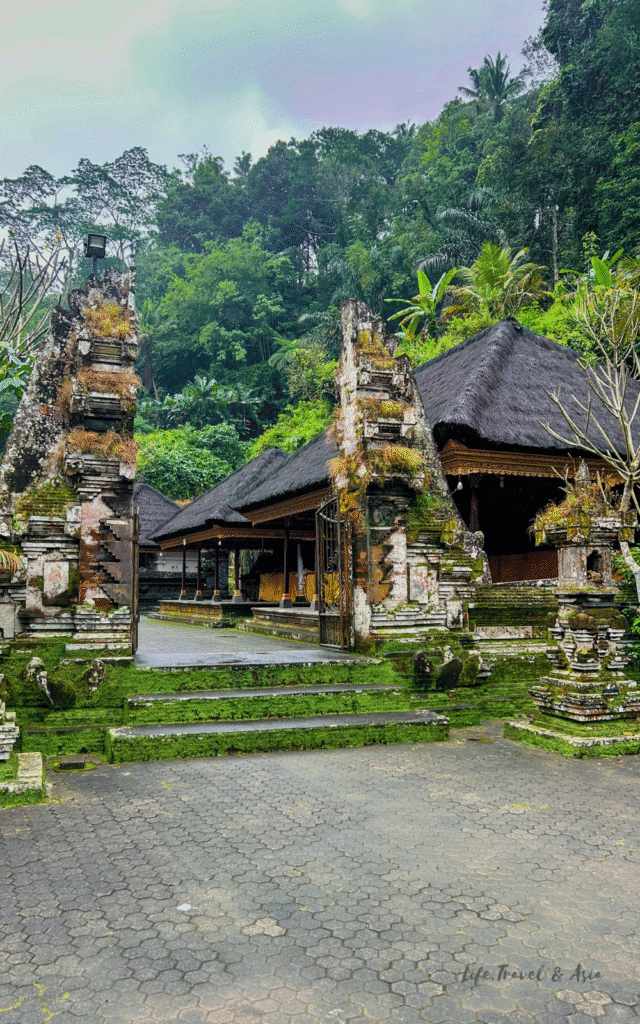
Once I arrived, around 8 a.m., all the souvenir stalls were closed, and there was no one else around. At least I avoided the crowds and could explore the temple in peace, take my photos and videos, and most importantly, enjoy the silence and sounds of nature around me.
However, to clarify, this is a visited site — I’ve seen it advertised by tour agencies here in Ubud. In fact, as I was leaving, a group of Japanese tourists showed up, and the peaceful atmosphere was gone. So, visiting early in the morning is definitely the way to go.
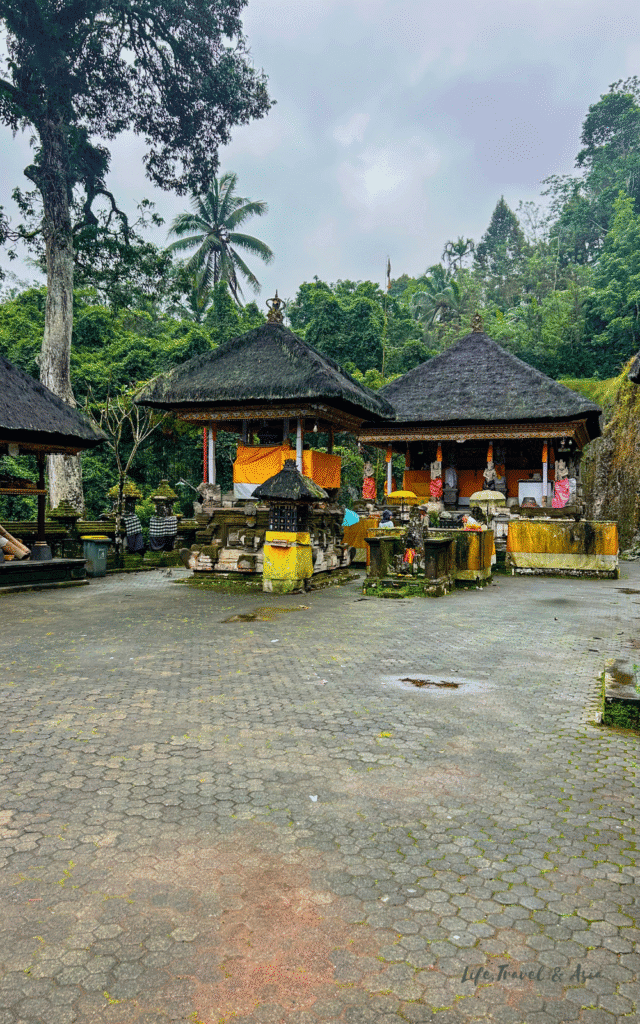
The last thing that left me a bit underwhelmed compared to other temples was the temple courtyards themselves. Coming from visiting Gunung Kawi Sebatu, which is smaller, maybe less mystical, but so much more beautiful from an architectural standpoint, the courtyards and pavilions at Gunung Kawi didn’t exactly impress me.
There wasn’t anything that caught my attention… no intricate carvings, statues, or charming corners. I walked through, took a few photos and videos, and headed straight back in front of the shrines.
Is Gunung Kawi Temple Worth Visiting?
I’m not here to tell you this site isn’t worth visiting — it is. It deserves your time, and honestly, if you love wandering around and noticing every little detail, you’ll enjoy exploring it properly.
However, based on your expectations, other sacred sites, such as Tirta Empul, Goa Gajah, Gunung Kawi Sebatu, or Pura Mengening, might be more aligned with what you’re looking for.
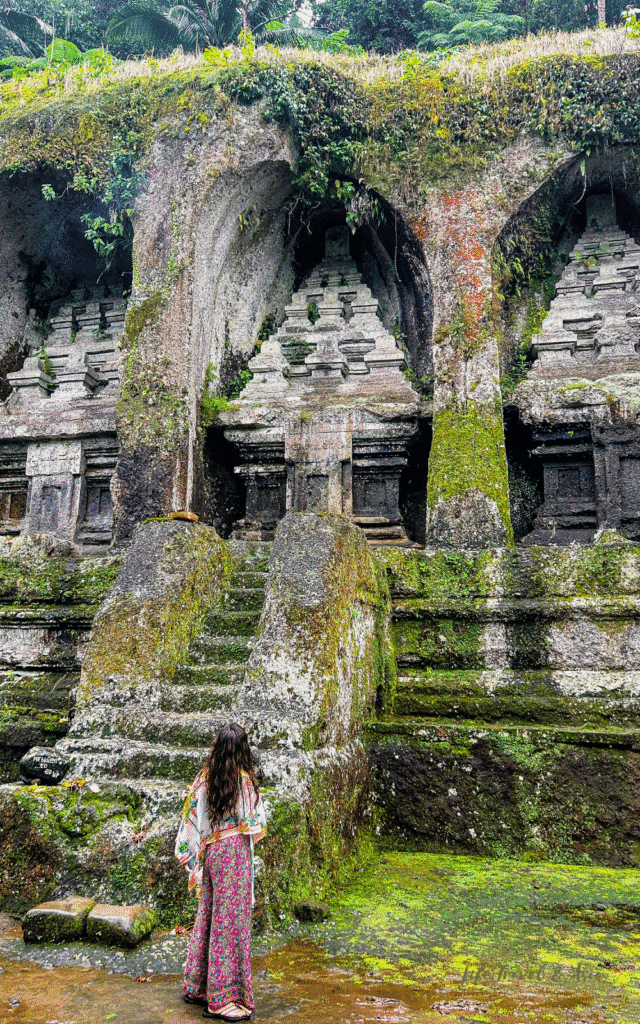
I’d say you should visit Gunung Kawi if:
- You’ve already explored a good number of Hindu temples and want to see something structurally different. In that case, the funerary complex, with its towering shrines carved into the cliff, is a great option to mix things up (yes, there’s still the temple courtyard, but honestly, its beauty doesn’t compare to that of other temples).
- You’re looking for a mystical, quiet spot where nature is not just the backdrop, but part of the whole experience.
It might not be for you if:
- You’re after that classic Balinese temple architecture, full of detailed carvings and vibrant shrines. In that case, Tirta Empul or Gunung Kawi Sebatu are probably more your thing.
How To Explore The Temple Grounds
My first tip for exploring the temple? Go early. It’s the best way to enjoy the whole place to yourself and take your time to wander around, walk down every staircase, get closer to the riverbed, and even approach the little waterfall.
Once you’ve made your way down the entrance stairs, you’ll reach the first part of the temple on your left — this is where the first four candi (shrines) are located, even before crossing the wooden bridge.
From here, you already get a beautiful view of the other side of the temple, the river flowing through, the waterfall, and the jungle all around. Right in front of these candi, you’ll also spot the classic multi-tiered Meru shrines.
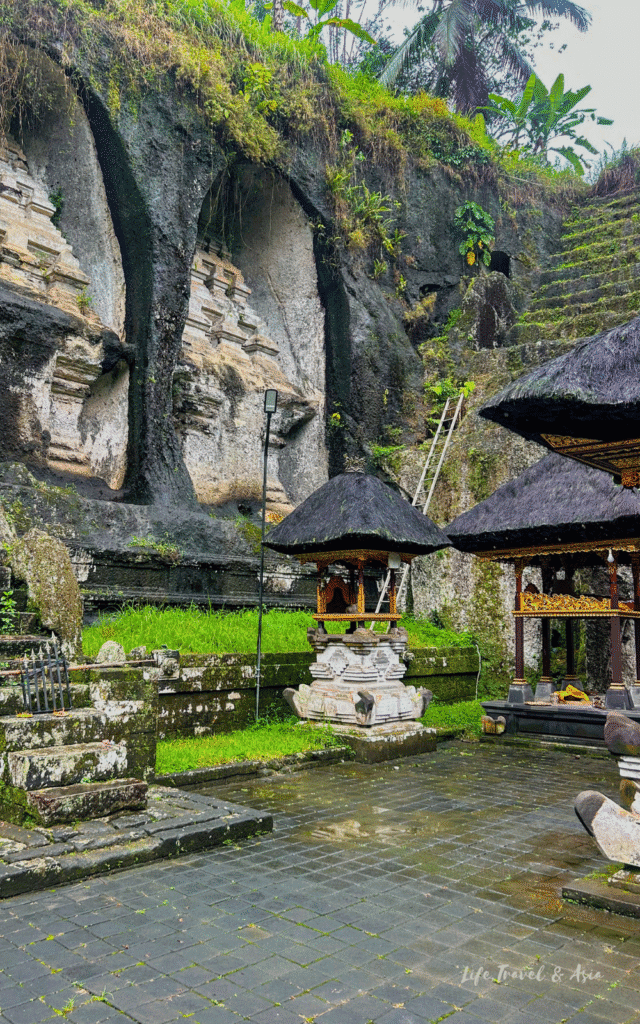
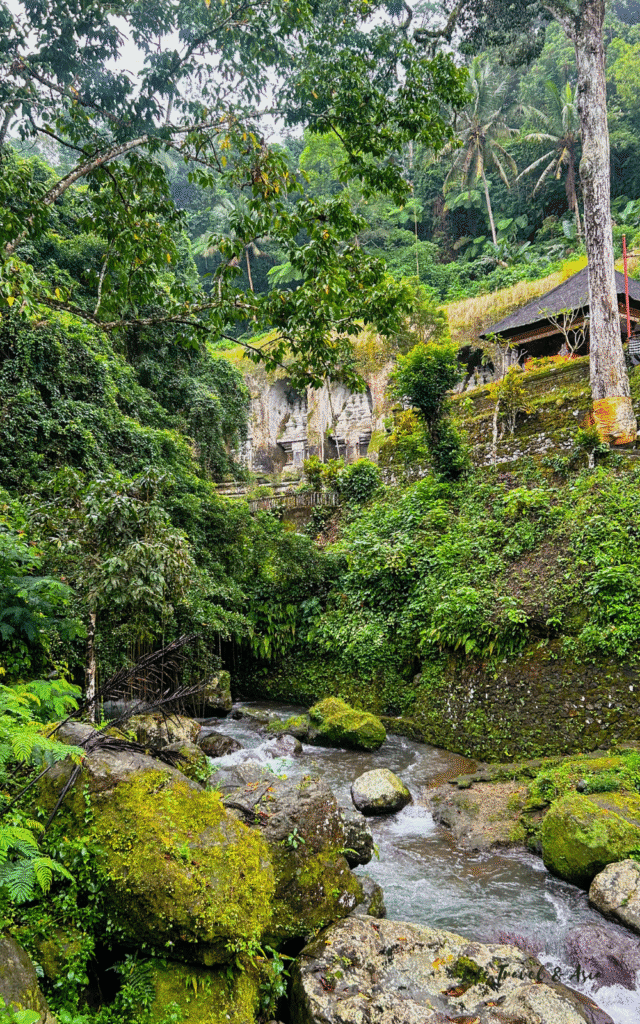
Once you’ve crossed the little bridge and taken in the view of the mighty river rushing beneath you, you can take the staircase on the right that leads you to the first candi bentar, the classic Balinese split gate that marks the entrance to the temple’s outer courtyard.
As I mentioned, the two inner courtyards of Pura Gunung Kawi itself aren’t particularly impressive — at least not to me. What’s truly stunning is walking through them and reaching the second area, where the five majestic candis rise, carved straight into the cliffside. This area is much more open and spacious than the previous one — the perfect spot to take photos.
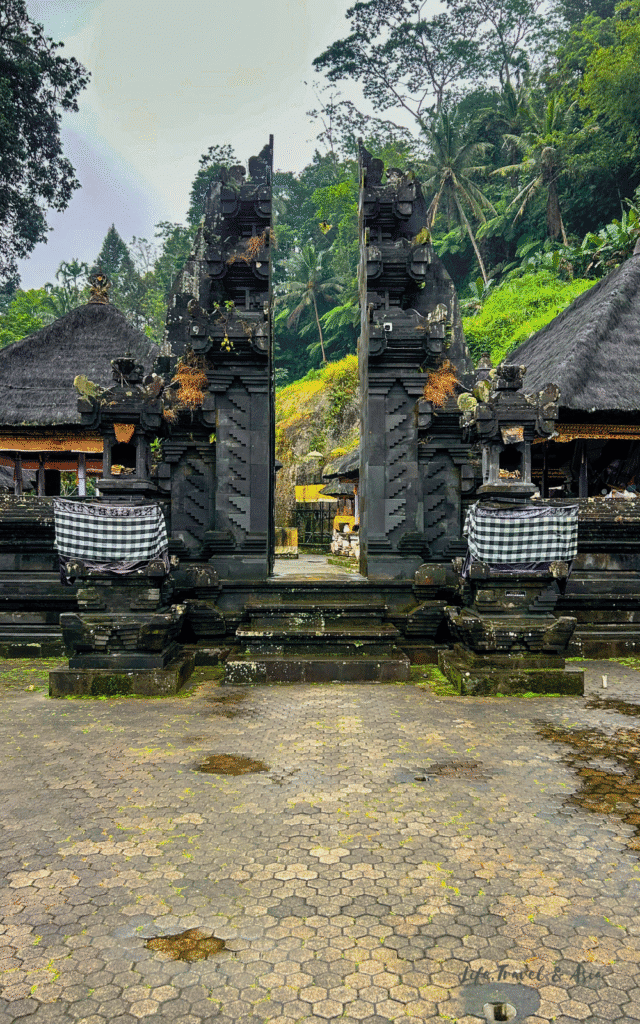
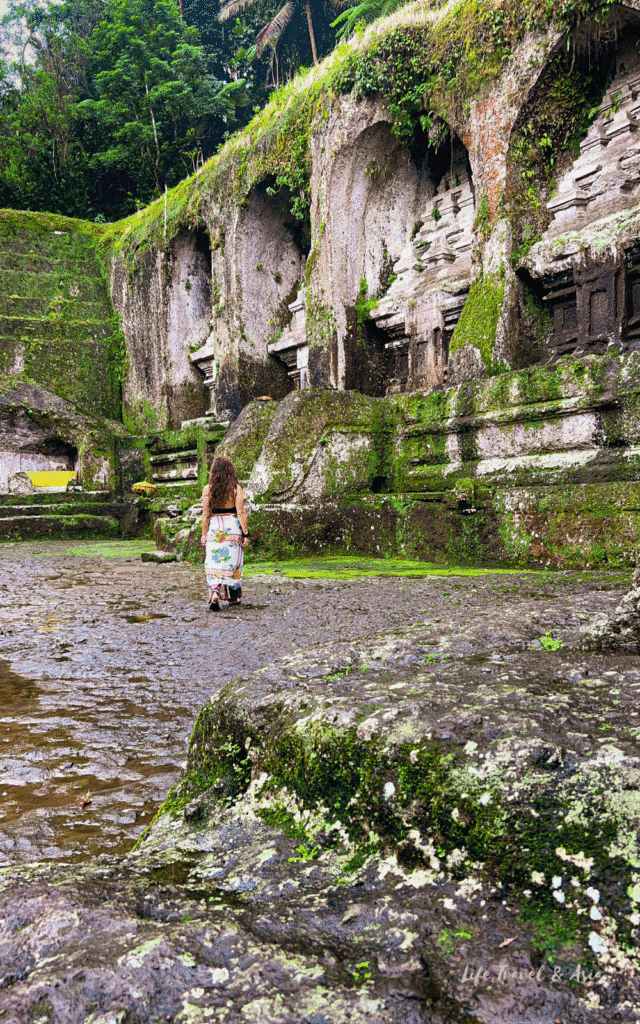
Drawn in by the candis, you might even miss the three little fountains trickling just behind the wall or the small path that leads down to the riverbed through another set of stairs. Make sure to take your time exploring every little corner of this part — it’s by far the highlight of the visit.
At this point, you probably have a pretty good idea of whether Gunung Kawi Temple deserves a spot on your Bali itinerary — or not. Let me help you plan your visit and share the practical information you’ll need.
And if you love finding hidden spots beyond the typical tourist trails, along with honest reviews, breakthrough moments, and personal growth insight from life in Asia, make sure to subscribe to my newsletter below. It’s where I share the real, unfiltered side of exploring and living here.
Join the Journey
Planning Your Visit
How To Get There
Gunung Kawi Temple is located in Tampaksiring, about 16 km from central Ubud, and you’ve got a few options to get there.
- Grab Bike: The easiest (and my personal favorite) is hopping on a Grab bike. It costs around IDR 50K (about $3) and will get you there in roughly 35 minutes, depending on traffic. Plus, you get to skip the worst of the traffic and enjoy the changing scenery as you leave the busy streets of Ubud behind. Honestly, that’s one of the best parts of exploring the areas north of town.
- Grab Car: If you’re not comfortable on a bike or you’re traveling with friends, you can book a Grab car instead. Expect to pay around IDR 80-90K for the ride. Just keep in mind that if you’re coming back later in the day, especially between June and August, you may end up stuck in traffic for a bit.
- Rent a Scooter: Finally, if you feel confident driving around Ubud, renting a scooter is a great way to explore with total flexibility. You can even plan a full day visiting temples, waterfalls, and hidden spots north of Ubud.
Other Useful Information: Entrance Fee, Dress Code & Best Time to Visit
The entrance fee to the temple is IDR 75K (around $5), and they’ll provide you with a sarong if you don’t have your own, plus a sash to tie around your waist. I finally solved the mystery — the traditional Balinese temple attire is open on top, so covering your shoulders isn’t mandatory.
If it has rained recently, wearing something short is honestly a better option. I had long trousers on, and they got completely soaked walking around the temple grounds.
The best time to visit is, of course, during the dry season — even though this year, the dry season seems totally confused and we’ve had plenty of rain.
Either way, to avoid the crowds, I highly recommend arriving right at opening time, which is 8:00 a.m. That way, you’ll dodge the endless sellers trying to get you to buy everything under the sun and enjoy the place before the tour groups show up.
Best Tours of Gunung Kawi Temple
Here are some tours I highly recommend if you want to benefit from the knowledge of a local guide while visiting the temple and make the most of your time in the area, especially if you’re short on time and don’t want to deal with transportation and pack a couple of sights into a one-day itinerary.
These tours include Gunung Kawi as well as other Ubud and Bali highlights.
Balinese history, Goa Gajah & Gunung Kawi: If you’re curious to dive deeper into Balinese history and pre-Hindu legends, this tour is a great option. It starts with a stop at Tirta Empul, one of the island’s most sacred water temples, followed by a visit to Gunung Kawi and Goa Gajah — incredible locations where history, spirituality, and nature blend. Along the way, you’ll also explore the Yeh Pulu archaeological site and the Balinese history museum of Gedong Arca.
Sacred Temples and Sunset Private Tour: If you’re up for a full day of temples, culture, and stunning views, this private tour is a great choice. You’ll explore some of Bali’s most famous temples like Goa Gajah, Gunung Kawi, and Tirta Empul. The tour also includes Taman Ayun, the Royal Family Temple, and wraps up with sunset at the iconic Tanah Lot. It’s definitely packed, but a good way to experience some of Bali’s highlights in one go.
Things To Do Around Gunung Kawi
There must be something special in the air around here, because this area is packed with sacred sites. Close to Gunung Kawi, you’ll find:
Pura Tirta Empul (5 minutes): Not to practice the Melukat ritual, Tirta Empul is way too chaotic for that, but to explore the temple grounds. The temple itself is stunning and worth a visit.
Pura Mengening (3 minutes): This is the temple where I practiced my purification ceremony and couldn’t be more adapted. Even without practicing the ritual, the temple is so worth it. It’s tiny, but its natural beauty and sacred atmosphere are what make it truly special.
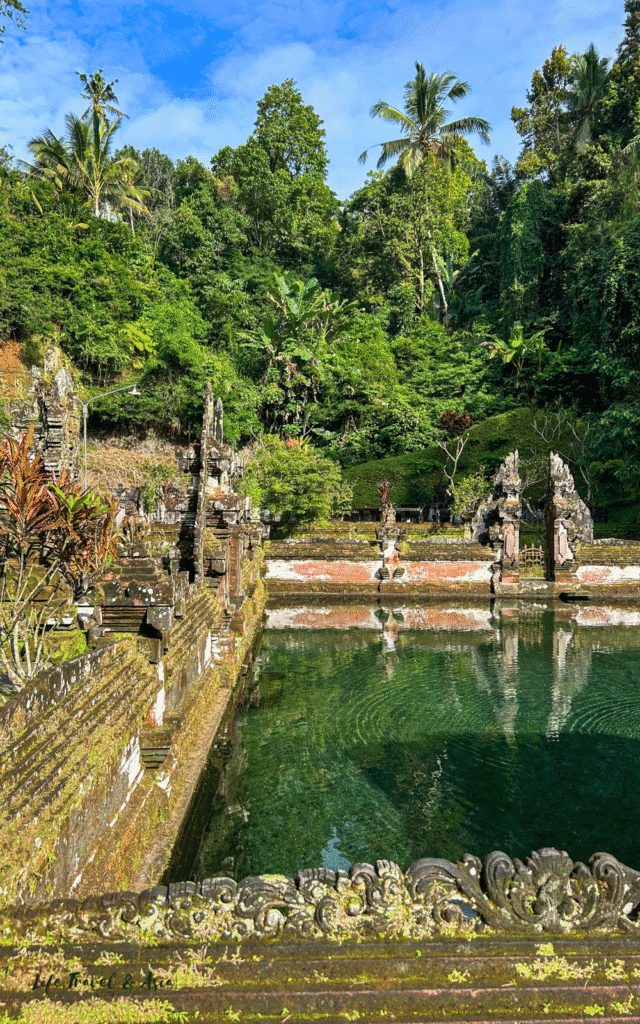
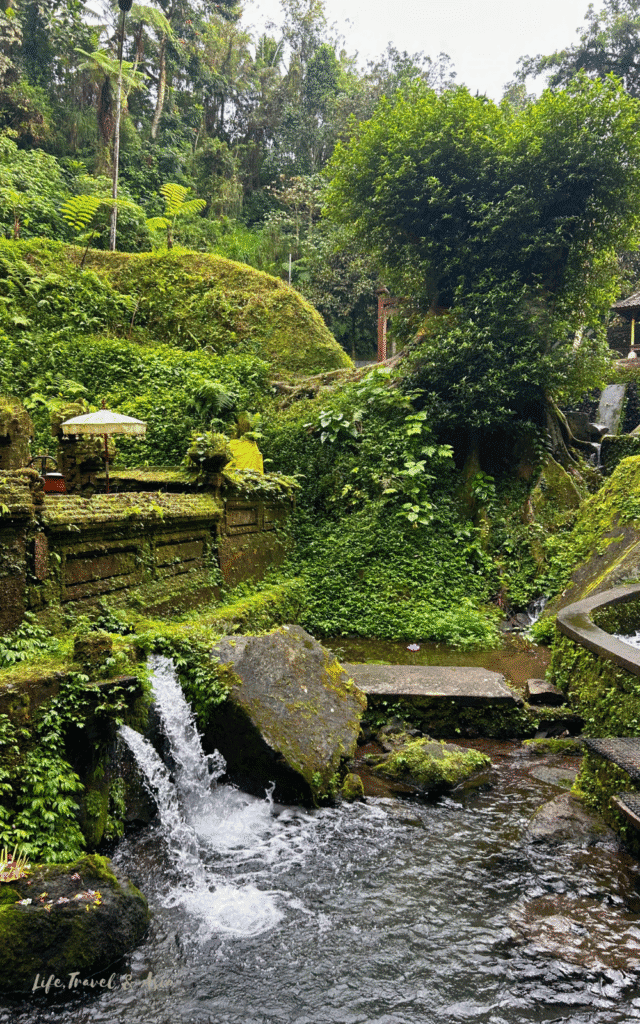
Pura Gunung Kawi Sebatu (11 minutes): Almost the same name, but a completely different temple. This small water temple tucked away in the middle of the jungle had already won my heart, even before I got in, while I was still in the backseat of my Grab bike. It’s so enchanting that it almost made me emotional.
Tegallalang Rice Terraces (20 minutes): If you’re coming from Ubud, the Tegallalang rice terraces make for a perfect intermediate stop to break up all the temple hopping with a little dose of Bali’s nature.
Mancigan Rice Terraces: Alternatively, if you want to explore some rice terraces but avoid the touristy site of Tegallalang, the Mancigan rice terraces are equally stunning but far less visited. They are located right beside Gunung Kawi.
There you go, that’s my honest (and a bit opinionated) take on Gunung Kawi Temple. Hopefully, this helped you decide if this ancient site deserves a spot on your Bali itinerary — or if maybe another temple around Ubud is more your cup of tea.
If you’ve already been or you’re planning to visit, I’d love to hear your thoughts in the comments — did it live up to the mystical hype or not?
And if you enjoy real, no-fluff travel tips, hidden gems, and honest takes from someone living and exploring Asia, make sure to subscribe to my newsletter below. I share the behind-the-scenes, the best spots (and the overrated ones), plus little life stories and personal growth moments from Bali and beyond.
Join the Journey !
Did you find it helpful? 📌 Save it on Pinterest!
